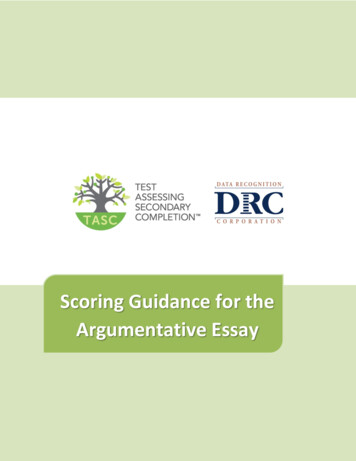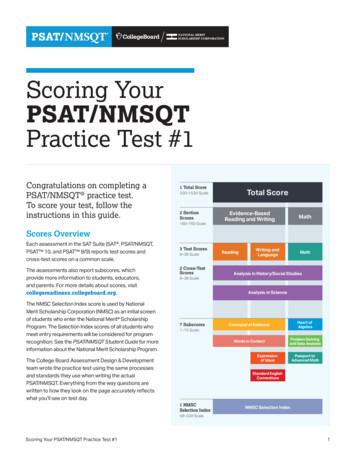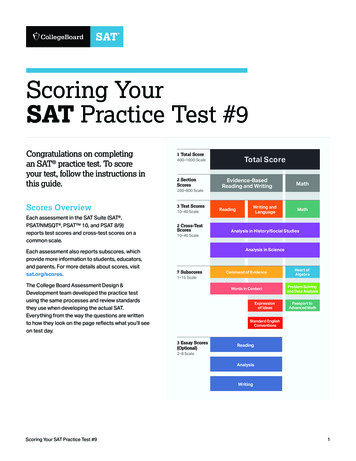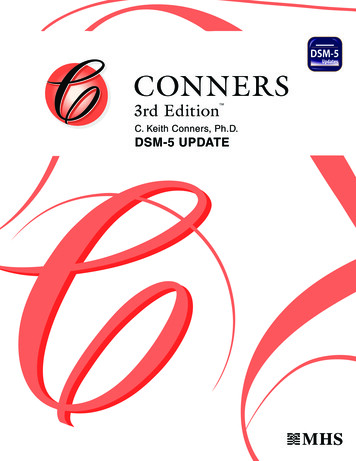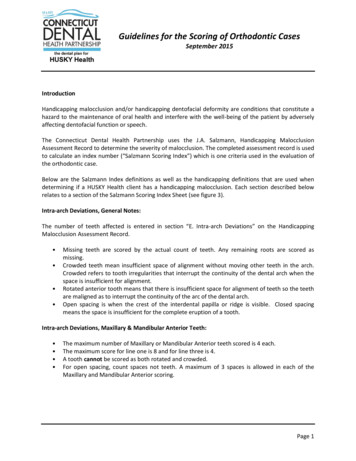
Transcription
Guidelines for the Scoring of Orthodontic CasesSeptember 2015IntroductionHandicapping malocclusion and/or handicapping dentofacial deformity are conditions that constitute ahazard to the maintenance of oral health and interfere with the well-being of the patient by adverselyaffecting dentofacial function or speech.The Connecticut Dental Health Partnership uses the J.A. Salzmann, Handicapping MalocclusionAssessment Record to determine the severity of malocclusion. The completed assessment record is usedto calculate an index number (“Salzmann Scoring Index”) which is one criteria used in the evaluation ofthe orthodontic case.Below are the Salzmann Index definitions as well as the handicapping definitions that are used whendetermining if a HUSKY Health client has a handicapping malocclusion. Each section described belowrelates to a section of the Salzmann Scoring Index Sheet (see figure 3).Intra-arch Deviations, General Notes:The number of teeth affected is entered in section “E. Intra-arch Deviations” on the HandicappingMalocclusion Assessment Record. Missing teeth are scored by the actual count of teeth. Any remaining roots are scored asmissing.Crowded teeth mean insufficient space of alignment without moving other teeth in the arch.Crowded refers to tooth irregularities that interrupt the continuity of the dental arch when thespace is insufficient for alignment.Rotated anterior tooth means that there is insufficient space for alignment of teeth so the teethare maligned as to interrupt the continuity of the arc of the dental arch.Open spacing is when the crest of the interdental papilla or ridge is visible. Closed spacingmeans the space is insufficient for the complete eruption of a tooth.Intra-arch Deviations, Maxillary & Mandibular Anterior Teeth: The maximum number of Maxillary or Mandibular Anterior teeth scored is 4 each.The maximum score for line one is 8 and for line three is 4.A tooth cannot be scored as both rotated and crowded.For open spacing, count spaces not teeth. A maximum of 3 spaces is allowed in each of theMaxillary and Mandibular Anterior scoring.Page 1
Guidelines for the Scoring of Orthodontic CasesSeptember 2015Intra-arch Deviations, Maxillary & Mandibular Posterior Teeth: A missing tooth must be congenitally missing. Remaining roots are scored as missing.Crowding is defined as insufficient space for alignment without moving other teeth in the arch.Crowded refers to tooth irregularities that interrupt the continuity of the dental arch when thespace is insufficient for alignment. A tooth scored as crowded is not concomitantly scored asrotated. The maximum of 2 teeth per quadrant per arch can be counted.Rotation denotes the buccal or lingual surface of the tooth wholly or partially faces the proximalsurface of adjacent teeth which is 45 degrees or greater.Closed spacing is defined as insufficient space for complete eruption of tooth.Rotated posterior teeth: the buccal or lingual surface of the tooth wholly or partially facesproximal surface of adjacent teeth which is 45 degrees or more;Open spacing: The crest of the interdental papilla is visible. Score each papilla in the incisorsection; score the posterior teeth when both adjacent crests of the interproximal papillae arevisible. The maximum of 2 teeth per quadrant per arch can be scored; andClosed spacing: The space is insufficient for complete eruption of a tooth. Cannot have closedspacing and crowding for the same teeth.The top of Figure 1 shows an example of crowding, spacing and missing teeth. The bottom of Figure 1shows anterior spacing.Figure 1Page 2
Guidelines for the Scoring of Orthodontic CasesSeptember 2015Inter-arch Deviations, Anterior Segment:The number of teeth affected is entered in section “F. Inter-arch Deviations, 1. Anterior Segment” on theHandicapping Malocclusion Assessment Record. Overjet is the labioaxial inclination of maxillary incisor teeth with mandibular incisorsoccluding on or over palatal mucosa. For an incisor to be scored as having excess overjet, anyportion of the maxillary incisal edge must be at least 3mm ahead of the opposing lowerincisor, measured from the labial of mandibular incisor to the lingual of the maxillary incisor.Overbite is when the maxillary incisors occlude on or opposite to the labiogingival mucosa orthe mandibular incisors occlude DIRECTLY on the palatal mucosa. Overbite is scored withteeth 7, 8, 9, 10 that are in a Class II Div. 2 occlusion when these teeth touch the lower labialgingiva.Overjet and overbite will score both when the mandibular incisors occlude directly on thepalatal mucosa and the maxillary incisors are in overjet.Open bite is the vertical separation between teeth in opposing dental arches when the rest ofthe teeth are in terminal occlusion. Edge-to-edge occlusion is not scored as open bite or across bite.Figure 2 shows an example of A) Overjet, where the maxillary incisors are labially inclined to themandibular incisors while the mandibular incisors are over the palatal mucosa, B) Overbite, where themandibular incisors are on the palatal mucosa and C) Overjet with Overbite, where the maxillary incisorsare labially inclined and the mandibular incisors are on the palatal mucosa.Figure 2Page 3
Guidelines for the Scoring of Orthodontic CasesSeptember 2015 Incisor Crossbite is when the maxillary incisors are lingual to the mandibular incisors whenposterior teeth are in terminal occlusion.Crossbite of posterior teeth is when the canines, premolars, and first molars are buccally orlingually placed out of the entire occlusal contact with their opposing teeth. The tooth’s cusptip is out of the fossa. Edge to edge is NOT considered a crossbite.Erupting teeth cannot be counted as an open bite. The tooth must be fully erupted.Inter-Arch Deviations, Posterior Segment:The number of teeth affected is entered in section “F. Inter-arch Deviations, 2. Posterior Segment” onthe Handicapping Malocclusion Assessment Record. Relate the mandibular teeth to the maxillary teeth.A. Distal Category is for Class IIB. Mesial Category is for Class IIIA flush terminal plane neither Class II nor III.The opposing cusp must be past the tip of the cusp of the tooth in the opposing arch.Page 4
Guidelines for the Scoring of Orthodontic CasesSeptember 2015Inter-arch DeviationsOpen Bite Anterior/PosteriorCross Bite Anterior/PosteriorMesio - Distial DeviationsPage 5
Guidelines for the Scoring of Orthodontic CasesSeptember 2015Salzmann Scoring Index SheetFigure 3Page 6
Guidelines for the Scoring of Orthodontic CasesSeptember 2015Comments Section:Any additional deviations should be entered in “G. Other Deviations, Comments” on the HandicappingMalocclusion Assessment Record.A narrative only applies to additional clinical considerations to justify the case qualifying for treatment.An example is the patient is under therapy from a licensed child psychologist or psychiatrist for themalocclusion. Additional information, a standard set of eight photos, x-rays, etc. that support thenarrative must be included. Do not send the treatment plan or mechanics to be employed as these donot alter the scoring of the case.X-rays must be printed on photo quality paper. Copy paper prints will not be accepted. The panoramicradiograph must be of diagnostic quality and relevant time-wise in relation to the models submitted. Allsubmitted models must be of diagnostic quality and trimmed in occlusion, with unattached wax bite, toABO guidelines. Poorly trimmed models and models with broken teeth will be returned ungraded.Criteria for Approval D8020 – Limited Orthodontic Treatment of the Transitional Dentition:Code D8020 is to be used for limited treatment of the transitional dentition for appliances such as BitePlanes, Rapid Palatal Expanders (RPE), Face Mask treatment, and Class II correctors. In addition,removable appliances to correct a tooth in crossbite and removable devices to regain space lost fromearly extraction of a second primary molar. To qualify for approval the following should be met: Bite Planes: the patient must show evidence of deep impinging overbite.RPE: the submitting orthodontist must provide proof of functional deviation.Face Mask: must submit a lateral view radiograph showing the mandibular growth exceedingthe growth of the upper jaw. Patient should have a negative ANB difference as determined by acephalometric x-ray.Correction of tooth in crossbite: the crossbite must be causing gingival recession as evidencedon study models.Class II correctors: the study models should show severe overjet of more than 9 mm and a fullClass II molar occlusion.Criteria for Approval D8220 Fixed Appliance Therapy:Code D8220 is for the use of fixed appliance therapy in order to correct habits such as tongue thrustingand thumb sucking. Approval is based on the following: For correction of thumb sucking habits, models should show evidence of open bite or severeprotrusion.For correction of tongue thrusting habits, models should show evidence of severe open bite.Page 7
Guidelines for the Scoring of Orthodontic CasesSeptember 2015Note: Clients who complete Phase 1 treatment must meet sufficient points when submitting for Phase IItreatment.Approvals for Scores Under 26 Points:It is possible for orthodontic treatment to be approved under 26 points if any of the following criteriaare met: Impactions of incisors, premolars and second molars requiring a surgical exposure procedure.Posterior impactions that are better off being extracted, such as totally blocked out or impactedsecond premolars caused by early loss of deciduous second molars will not be approved.Impacted mandibular cuspids that cannot be brought into the dental arch will not be approved.Functional deviations affecting the mouth and underlying structures.A letter from a licensed child psychologist or psychiatrist stating that an on-going emotionalproblem is caused by patient’s aesthetic appearance.A complete anterior crossbite causing gingival recession to the lower anterior teeth.Skeletal Class III malocclusion. Patient should have a negative ANB difference as determined bya cephalometric x-ray.Anterior Impactions including central incisors, lateral incisors and canines in the maxillary andmandibular arches. This condition is considered to be a handicapping malocclusion.An overjet greater than 9mm: this is recorded with the patient in the centric occlusion andmeasured from the labial of the lower incisor to the lingual of the upper incisor. Themeasurement could apply to a protruding single tooth as well as to the whole arch. Themeasurement is read and rounded off to the nearest millimeter and entered on the form. Thiscondition is considered to be a handicapping malocclusion.Brodie bite malocclusions, either unilateral or bilateral, with the first bicuspid, second bicuspid,and first molar in total buccal crossbite will be considered to be a handicapping malocclusion.The Orthodontic Qualifying Score:In order to qualify for orthodontic coverage in the HUSKY Health Program, the minimum scoring formedical necessity will be 26 points and greater, which will make Connecticut consistent with otherstates’ minimum scoring requirement.A strict adherence to the Salzmann standard must be observed by dental providers. The mandatorystandards are posted to the CTDHP Web site at www.CTDHP.com under the “Provider Partners” section.Approval of cases may be denied or delayed if the following information is not included at the time ofsubmission for case evaluation:Page 8
Guidelines for the Scoring of Orthodontic CasesSeptember 2015 Any medical/behavioral health conditions should be recorded on the Salzmann scoring sheetwith supporting documentation at the time of submission.Radiographs must be of diagnostic quality or they will not be reimbursed.Diagnostic casts must be properly trimmed or they will not be reimbursed.Reimbursements for radiographs and the diagnostic casts of clients will only occur for properly scoredSalzmann Indices with scores equal to or greater than 24 points. If the score is less than 24 points asdetermined on the assessment done by the CTDHP orthodontic consultant, then reimbursement for theradiographs or diagnostic casts will be denied.Cases may either be submitted electronically or in physical form. For information on how to submitorthodontic cases electronically, please contact BeneCare at 215-440-1025 or physical cases may bemailed to:Orthodontic Case Reviewc/o BeneCare Dental Plans195 Scott Swamp Road, Suite 101Farmington, CT 06032Page 9
Guidelines for the Scoring of Orthodontic Cases September 2015 Page 3 Inter-arch Deviations, Anterior Segment: The number of teeth aff





